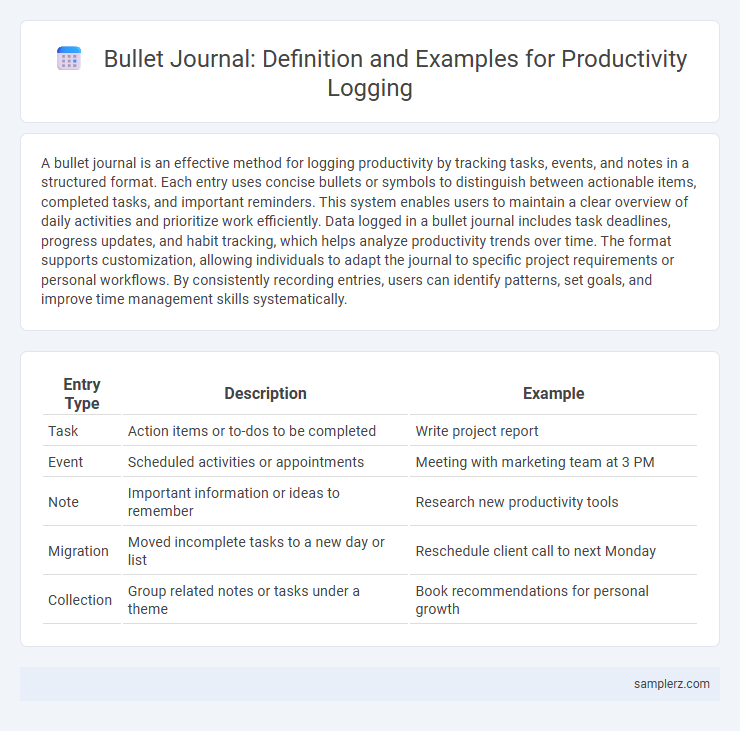A bullet journal is an effective method for logging productivity by tracking tasks, events, and notes in a structured format. Each entry uses concise bullets or symbols to distinguish between actionable items, completed tasks, and important reminders. This system enables users to maintain a clear overview of daily activities and prioritize work efficiently. Data logged in a bullet journal includes task deadlines, progress updates, and habit tracking, which helps analyze productivity trends over time. The format supports customization, allowing individuals to adapt the journal to specific project requirements or personal workflows. By consistently recording entries, users can identify patterns, set goals, and improve time management skills systematically.
Table of Comparison
| Entry Type | Description | Example |
|---|---|---|
| Task | Action items or to-dos to be completed | Write project report |
| Event | Scheduled activities or appointments | Meeting with marketing team at 3 PM |
| Note | Important information or ideas to remember | Research new productivity tools |
| Migration | Moved incomplete tasks to a new day or list | Reschedule client call to next Monday |
| Collection | Group related notes or tasks under a theme | Book recommendations for personal growth |
Daily Task Tracker: Structuring Your To-Do List
A Daily Task Tracker in a bullet journal organizes your to-do list with clear priorities, deadlines, and progress indicators, enhancing time management and focus. Using symbols like dots for tasks, circles for events, and checkmarks for completed items streamlines task identification and tracking. Incorporating space for notes and reflections allows for adjustments and improved productivity insights over time.
Habit Tracker: Monitoring Daily Routines
Habit Tracker in a bullet journal enables precise monitoring of daily routines by visually representing consistency and progress across various activities such as exercise, hydration, and mindfulness. This tool helps identify patterns and triggers, allowing users to fine-tune behaviors to enhance productivity. Regular use of a habit tracker fosters accountability and reinforces positive habits, contributing to sustained personal growth and time management.
Mood Log: Visualizing Emotional Patterns
Mood logs in bullet journals serve as powerful tools for visualizing emotional patterns over time, enabling users to identify triggers and trends in their mental well-being. By employing color-coded symbols or simple graphs, these logs transform subjective feelings into quantifiable data, facilitating mindfulness and proactive mood management. Consistent mood tracking enhances self-awareness and supports targeted strategies to improve overall productivity and emotional health.
Project Progress Chart: Breaking Down Big Goals
The Project Progress Chart in a bullet journal visually tracks key milestones and task completion rates, enabling clear measurement of ongoing productivity for large projects. This method breaks down complex objectives into manageable segments, promoting consistent progress and reducing overwhelm. Logging progress through color-coded charts or symbols increases motivation and highlights priorities for effective time management.
Time Blocking Schedule: Managing Your Day by Hours
Bullet journal time blocking schedules allocate specific hours to tasks, enhancing focus and minimizing distractions. By logging activities hour-by-hour, users track progress and adjust priorities throughout the day. This method improves time management, boosts productivity, and reduces procrastination in daily workflows.
Gratitude Log: Cultivating Positive Mindsets
A Gratitude Log within a bullet journal helps cultivate positive mindsets by encouraging daily reflection on things to be thankful for, enhancing emotional well-being. Tracking gratitude consistently promotes mindfulness and reduces stress, supporting mental health and productivity. Integrating this practice into daily routines leads to increased motivation and a more optimistic outlook.
Meeting Notes: Capturing Action Items and Ideas
Bullet-journaling in meeting notes enhances productivity by efficiently capturing action items and ideas, promoting clear accountability and follow-up. Structured logs with bullet points enable quick reference and prioritization of tasks, reducing information overload. Integrating symbols and signifiers organizes content, making retrieval and review seamless for project management and decision-making.
Weekly Review Spread: Reflecting on Achievements
The Weekly Review Spread in a bullet journal enhances productivity by systematically logging achievements, allowing individuals to track progress and identify patterns. This structured reflection helps prioritize tasks for upcoming weeks, boosting focus and motivation. Incorporating key metrics like completed tasks, goals met, and challenges overcome optimizes time management and personal growth.
Priority Matrix: Sorting Urgent vs. Important Tasks
Using a bullet journal with a Priority Matrix enables efficient logging by categorizing tasks into urgent and important quadrants, enhancing focus on high-impact activities. This method clarifies task prioritization, helping to avoid time spent on urgent but non-essential duties while ensuring critical deadlines are met. Incorporating visual symbols and color codes within the bullet journal boosts cognitive recognition and task management accuracy.
Goal Setting Log: Mapping Out Short and Long-Term Objectives
A Goal Setting Log in a bullet journal helps track progress by clearly outlining both short-term tasks and long-term aspirations, allowing for measurable milestones and deadlines. This method enhances productivity by breaking down complex objectives into actionable steps, fostering accountability and motivation. Utilizing specific symbols and indexing in the bullet journal streamlines reviewing and adjusting goals regularly.

example of bullet-journal in logging Infographic
 samplerz.com
samplerz.com